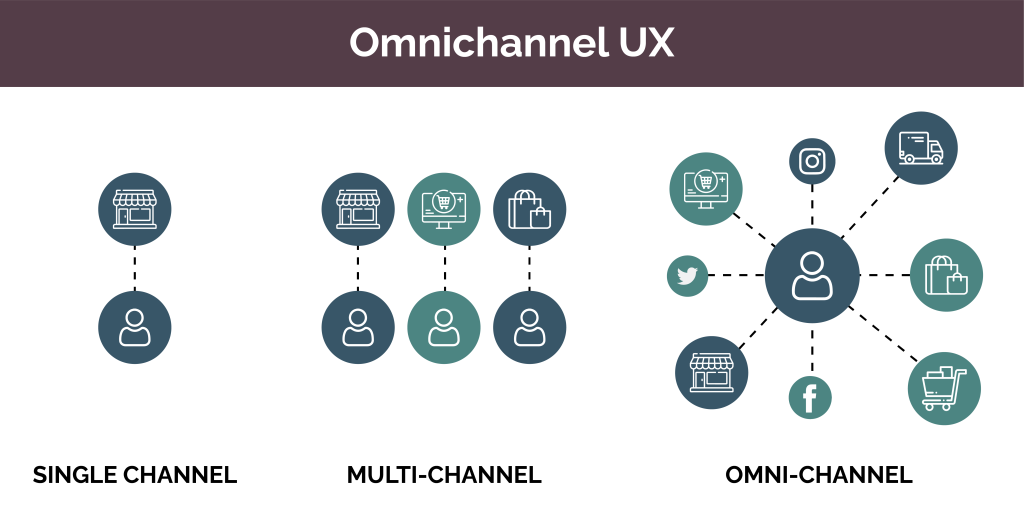In 2021 there were 4.66 billion active internet users. Almost everyone in the world has access to the internet, and it has become an essential part of everyday life for billions. Today you can access the internet in various ways through smartphones, PCs, TVs, tablets, and many more devices; as a result, companies are presented with the challenge of designing their user experience for all sorts of channels. A brand is considered a whole entity by customers, and they want to receive a unified experience. But how is this accomplished? And what are the critical elements of a cross-channel experience?
This blog will take a brief look at the multi-device experience and how designers can create for all channels.
Multi-Channel Experience
The crux of the multi-channel experience is about allowing users to engage via various channels and provide a unified experience. 48% of households have multiple personal computers, 43% own a tablet or e-book, and around 85% of adults own smartphones. So it is essential to allow users to switch from one device to another and still be able to interact with your product or service in a way that is an enjoyable and consistent matter where or how the users reach the design, there should be a cohesive user experience with seamless data transfer across channels. So what elements should we focus on when creating a cross-channel experience? Let’s take a closer look.

Elements of a Usable Cross Channel Experience
- Consistency
First and foremost, we need to focus on consistency. Don’t surprise the customer by providing an inconsistent experience across each channel. Instead, place the customer at the center of the design process and create a unified experience that addresses their needs on each device. Some functional and visual optimization will have to be altered to ensure a high-class product, but elements such as navigation and content should generally remain consistent.
- Availability
The omnichannel experience should be available across all touchpoints. Companies should allow their users to decide when and how to access their services. This means removing limits and ensuring maximum freedom with each channel.
- Seamless Integration
Can a user start a task on one channel and complete it via another? This is called seamless integration. There should be a real-time data sync between all channels, enabling a seamless user experience.
- Context Optimisation
You don’t need to deliver everything all the time. A context-driven perspective will help to improve the customer experience. For example, different devices may be better suited for other sorts of activities. Therefore, consistency across channels contexts will help customers get the most out of each experience.

Building a Cross-Channel Experience Strategy
The elements we need to focus on are clear. Now we should consider the actual steps designers can take to ensure they are incorporating these elements and building an actual cross-channel experience.
- Common Goals: Before you implement anything, it is essential to align your team goals and metrics with its overall business goals. This will help designers measure performance, and it will simplify strategic decisions.
- Map Customer Journey: Understand your users and customers. Draw a customer journey map to find out how they interact with your product or service. Which touchpoints are most popular?
- Provide Value in Exchange for Data: If you ask for your users’ data, make sure you provide value in return. Know exactly what kind of data you’re collecting and understand how that information can improve the user experience.
- Check for Redundancies: Look out for interruptions or disturbances in the user journey. Recheck the journey map and ensure a seamless data flow across all channels.
- Measure, Analyse and Optimise: Collect data on standard metrics and understand whether the user experience you are delivering is living up to your expectations. Are your goals being met? Then you can continue to use the data to improve your existing strategies.
- Communicate the Results: The final step is to communicate your results. Let your team and other teams know the results of your analysis and any other findings. Transparency across the organization will help you work towards common goals and refine your cross-channel user experience.
Design for all Channels
Creating a unified experience across all channels is an exciting challenge for brands. In today’s world, users have certain expectations. Omni-channel synchronicity is important to users that interact with your product or service on various devices and via different channels. Building a cross-channel experience that incorporates all your product or service elements will be vital to expanding your user base and maintaining your success for years to come.
So, how do you design for all channels and deliver a consistently excellent UX? To learn more, get in contact with our UI and UX experts at Radiant Digital.


